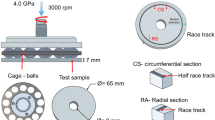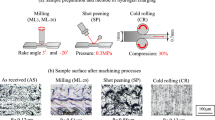Abstract
The effect of residual stress on fatigue behavior and mechanisms of carbonitrided AISI 1015 steel under uniaxial cyclic loading has been experimentally studied. By progressive removal of thin surface layers using an electropolishing technique and subsequent residual stress measurements using an x-ray diffraction technique, the compressive residual stress at the surface was approximately 900 MPa. The stress decreased toward the center, and became stable tensile residual stress of approximately 20 MPa. The fatigue resistance of carbonitrided AISI 1015 steel was higher than that of AISI 1015 steel due to the presence of compressive residual stress in case layer. The fatigue limit of AISI 1015 steels with and without carbonitriding was 340 and 300 MPa, respectively. Subsurface cracks initiated at the case-core interface, i.e. approximately 400 μm from the surface. With increasing number of stress cycles, the subsurface cracks coalesced and propagated intergranularly through the case layer. After some incubation cycles, the subsurface cracks reached the surface of specimen, and became a main crack. During this stage, the stress increased, and caused the formation of voids in core material. Consequently, the crack propagated through the core material, interacted with voids, and caused complete fracture.












Similar content being viewed by others
References
Croccolo D., Cristofolini L., Bandini M., Freddi A. Fatigue Strength of Shot-Peened Nitrided Steel: Optimization of Process Parameters by Means of Design of the Experiment. Fatigue Fract. Eng. Mater. Struct. 2002;25(7):695–707
Montross C.S., Wei T., Ye L., Clark G., Mai Y.W. Laser Shock Processing and its Effects on Microstructure and Properties of Metal Alloys: A Review. Intl. J. Fatigue 2002;24(10):1021–1036
Ahmed R., Hadfield M. Mechanisms of Fatigue Failure in Thermal Spray Coatings. J. Thermal Spray Technol. 2002;11(3):333–349
Widmark M., Melander A. Effect of Material, Heat Treatment, Grinding and Shot Peening on Contact Fatigue Life of Carburised Steels. Intl. J. Fatigue 1999;21(4):309–327
ASM Handbook, Volume 4: Heat Treating, J.R. Davis, Ed., ASM International, OH, 1994
Stephens R.I., Fatemi A., Stephens R.R., Fuchs H.O. Metal Fatigue in Engineering. 2nd ed. New York: Wiley-Interscience Publication, 2001
Collins J.A. Failure of Materials in Mechanical Design: Analysis, Prediction, Prevention. 2nd ed. New York: John Wiley & Sons, 1993
Farfan S., Rubio-Gonzalez C., Cervantes-Hernandez T., Mesmacque G. High Cycle Fatigue, Low Cycle Fatigue and Failure Modes of a Carburized Steel. Intl. J. Fatigue 2004;26(6):673–678
Karadag M., Stephens R.I. The Influence of High R Ratio on Unnotched Fatigue Behavior of 1045 Steel with Three Different Heat Treatments. Intl. J. Fatigue 2003;25(3):191–200
McEvily A.J., Pohl K., Mayr P. Comparison of the Fractographic Features of a Carburized Steel Fractured Under Monotonic or Cyclic Loading. Mater. Charact. 1996;36(4–5):153–157
Genel K., Demirkol M., Capa M. Effect of Ion Nitriding on Fatigue Behaviour of AISI 4140 Steel. Mater. Sci. Eng. A 2000;279(1–2):207–216
Przylecka M., Gestwa W., Kulka M. Influence of Carbonitriding and Heat Treatment on the Properties of Low- and High-Carbon Steels. Mater. Sci. Forum 1994;163–6(Pt. 1):239–244
ASTM E466-96: Conducting Force Controlled Constant Amplitude Axial Fatigue Tests of Metallic Materials, Volume 3.01, Annual Book of ASTM Standards, 1996
STM E1558-93: Electrolytic Polishing of Metallographic Specimens, Volume 3.01, Annual Book of ASTM Standards, 1996
ASTM E384-89: Microhardness of Materials, Volume 3.01, Annual Book of ASTM Standards, 1996
ASTM E8M-96: Tension Testing of Metallic Materials, Volume 3.01, Annual Book of ASTM Standards, 1996
ASM Handbook, Volume 1: Properties and Selection: Irons, Steels, and High-Performance Alloys, J.R. Davis, Ed., ASM International, OH, 1994
Genel K. Estimation Method for the Fatigue Limit of Case Hardened Steels. Surface Coat. Technol. 2005;194(1):91–95
Suresh S. Fatigue of Materials. 2nd ed. New York: Cambridge University Press, 1998
Ando T., Krauss G. The Effect of Phosphorus Content on Grain Boundary Cementite Formation in AISI 52100 Steel. Metal. Trans. A 1981;12A:1283–1290
Krauss G. Microstructure and Fracture of a Carburized Steel. Metal. Trans. A 1978;9A(11):1527–1535
Sankaran S, Subramanya Sarma V, Padmanabhan K.A., Jaeger G, Koethe A. High Cycle Fatigue Behaviour of a Multiphase Microalloyed Medium Carbon Steel: A Comparison Between Ferrite-Pearlite and Tempered Martensite Microstructures. Mater. Sci. Eng. A 2003; 362(1–2):249–256
Green M.R., Rainforth W.M., Frolish M.F., Beynon J.H. The Effect of Microstructure and Composition on the Rolling Contact Fatigue Behaviour of Cast Bainitic Steels. Wear 2007;263(1–6):756–765
Acknowledgments
The authors would like to acknowledge the discussions and supports from Prof. Y. Mutoh (Nagaoka University of Technology, Japan), Mr. N. Taweejun (Thai Tohken Thermo Co., Ltd.), Mr. S. Chaiyana, the Thailand Research Fund (TRF), the National Research Council of Thailand (NRCT), the Commission on Higher Education of Thailand, the Scientific and Technological Research Equipment Centre of Chulalongkorn University (STREC), and the National Metal and Materials Technology Center (MTEC).
Author information
Authors and Affiliations
Corresponding author
Rights and permissions
About this article
Cite this article
Kanchanomai, C., Limtrakarn, W. Effect of Residual Stress on Fatigue Failure of Carbonitrided Low-Carbon Steel. J. of Materi Eng and Perform 17, 879–887 (2008). https://doi.org/10.1007/s11665-008-9212-x
Received:
Revised:
Accepted:
Published:
Issue Date:
DOI: https://doi.org/10.1007/s11665-008-9212-x




